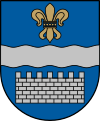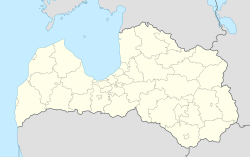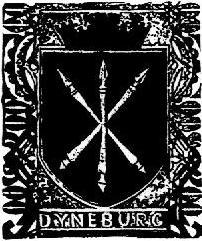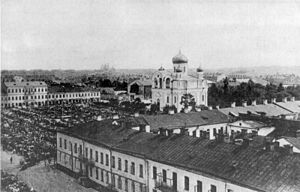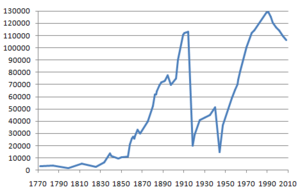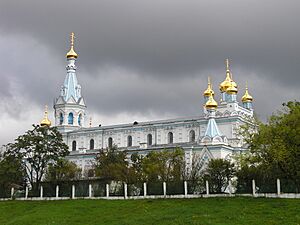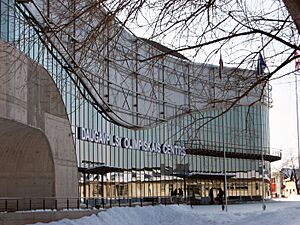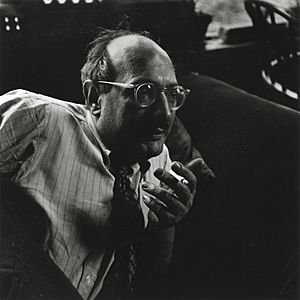Daugavpils facts for kids
Quick facts for kids
Daugavpils
|
|||
|---|---|---|---|
|
State city
|
|||
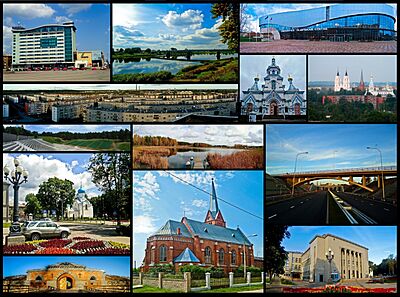
City from different points of view
|
|||
|
|||
| Country | Latvia | ||
| Established | 1275 | ||
| Town rights | 1582 | ||
| Area | |||
| • Total | Lua error in Module:Wd at line 1,575: attempt to index field 'wikibase' (a nil value). km2 (Formatting error: invalid input when rounding sq mi) | ||
| • Land | Lua error in Module:Wd at line 1,575: attempt to index field 'wikibase' (a nil value). km2 (Formatting error: invalid input when rounding sq mi) | ||
| • Water | Expression error: Unexpected < operator. km2 (Formatting error: invalid input when rounding sq mi) | ||
| Highest elevation | 139 m (456 ft) | ||
| Lowest elevation | 86 m (282 ft) | ||
| Population
(2024)
|
|||
| • Total | 77,799 | ||
| • Rank | 2 | ||
| Demonym(s) | Daugavpilieši (Latvian) | ||
| GDP | |||
| • State city | 857,673,000 Euro (2021) | ||
| • Per capita | 10,746 Euro (2021) | ||
| Time zone | UTC+2 (EET) | ||
| • Summer (DST) | UTC+3 (EEST) | ||
| Postal code |
LV-54(01–65)
|
||
| Calling code | (+371) 654 | ||
| Climate | Dfb | ||
Daugavpils is a big city in southeastern Latvia. It sits on the banks of the Daugava River, which is where it gets its name. The city is split by the river. The northern part is in the Latgale region, and the southern part is in Selonia.
Daugavpils is the second-largest city in Latvia, after the capital city, Riga. Riga is about 230 kilometres (143 miles) to the northwest. Daugavpils is also one of the most populated cities in the Baltic states. It is quite close to the borders of Belarus (33 km (21 mi)) and Lithuania (25 km (16 mi)). The Latvian border with Russia is about 120 km (75 mi) away.
This city is a very important railway hub and a center for factories. Historically, it was a key military city. It was located roughly halfway between Riga and Minsk, and between Warsaw and Saint Petersburg.
For a time, Daugavpils was called Dyneburg. It was the capital of Polish Livonia when it was part of the Polish–Lithuanian Commonwealth. In 1772, it became part of the Russian Empire. After World War II, most people in Daugavpils spoke Russian. Latvians and Poles were also large groups. In the past, German and Yiddish were also commonly spoken.
Contents
City Names Through History
In the Latvian language, the name Daugavpils means "Daugava castle." This is because "Daugava" is the river's name, and "pils" means "castle."
Over time, Daugavpils has had many different names in various languages. Some of these names are still used today.
- Belarusian: Даўґаўпілс (Daŭgaŭpils); also Дзвінск (Dzvinsk), Дынабурґ (Dynaburg)
- German: Dünaburg
- Estonian: Düünaburg, Väinalinn
- Finnish: Väinänlinna
- Latgalian: Daugpiļs
- Lithuanian: Daugpilis
- Polish: Dźwińsk, Dyneburg
- Russian: Даугавпилс (Daugavpils); also Невгин (Nevgin), Динабург (Dinaburg), Борисоглебск (Borisoglebsk), Двинск (Dvinsk)
- Yiddish: דענענבורג (Denenburg), דינאַבורג (Dinaburg), דווינסק (Dvinsk)
How the City's Name Changed
- Dünaburg (1275–1656)
- Borisoglebov (1656–1667)
- Dünaburg (1667–1893)
- Dvinsk (1893–1920)
- Daugavpils (since 1920)
City History

The story of Daugavpils began in 1275. The Livonian Order built Dünaburg Castle about 20 km (12 mi) up the Daugava river from where the city is now. In 1561, the castle became part of the Grand Duchy of Lithuania. Later, in 1569, it joined the Polish–Lithuanian Commonwealth.
In 1577, the Russian tsar Ivan the Terrible captured and destroyed Dünaburg castle. That same year, the Polish King Stephen Báthory built a new castle and town 20 km (12 mi) downriver. In 1582, Daugavpils was given Magdeburg rights, which meant it could govern itself like a town.
In 1621, Daugavpils became the capital of a new region called Inflanty Voivodeship. This region existed until 1772. In 1656, Russian troops captured Daugavpils and renamed it Borisoglebov. They controlled the area for 11 years. In 1667, Russia returned the region to the Polish–Lithuanian Commonwealth.
In 1772, Daugavpils became part of the Russian Empire. It was called Dinaburg at first, then Dvinsk later on.
Jewish Community in Daugavpils
Before 1941, Daugavpils had a very important Jewish community. By 1897, about 32,400 Jewish people lived there, making up 44% of the city's population. They were very active in business and crafts. By 1911, their numbers grew to 50,000. However, many Jewish people later moved away. By 1935, about 11,106 Jewish people remained in Daugavpils.
The city had a rich Jewish culture, with over 40 synagogues. Two famous rabbis lived here: Joseph Rosen and Meir Simcha of Dvinsk. They were known for their deep knowledge and writings.
A famous painter, Mark Rothko, was born in Daugavpils in 1903. He moved to the United States at age 10 and became a well-known abstract artist.
During World War II, the Jewish community in Daugavpils faced terrible events. In 1941, Nazi German forces invaded. Many Jewish people were forced into a special area called the Daugavpils Ghetto. Most of them were tragically killed. By 1944, when the town was freed, only about 100 Jewish people from the original community of 16,000 had survived.
Modern History of Daugavpils
The building of the Daugavpils fortress started in 1810 and finished in 1878. A new city center was built in the 19th century. In 1860, the city was connected to the Saint Petersburg-Warsaw railway line.
From 1893 to 1920, the city was called Dvinsk. In 1920, the newly independent Latvian state renamed it Daugavpils. Latvian, Polish, and Soviet troops fought battles in the area between 1919 and 1920.
Daugavpils and all of Latvia were under Soviet rule from 1940–41 and again from 1944–1991. Germany occupied the city between 1941 and 1944. During the Cold War, a Soviet air base operated near Daugavpils.
City Geography
Daugavpils Climate
Daugavpils has a humid continental climate. This means it has warm summers and cold winters.
| Climate data for Daugavpils (1991−2020 normals, extremes 1891−present) | |||||||||||||
|---|---|---|---|---|---|---|---|---|---|---|---|---|---|
| Month | Jan | Feb | Mar | Apr | May | Jun | Jul | Aug | Sep | Oct | Nov | Dec | Year |
| Record high °C (°F) | 11.1 (52.0) |
13.1 (55.6) |
18.4 (65.1) |
27.4 (81.3) |
31.8 (89.2) |
33.1 (91.6) |
35.1 (95.2) |
33.5 (92.3) |
31.3 (88.3) |
23.6 (74.5) |
16.3 (61.3) |
10.6 (51.1) |
35.1 (95.2) |
| Mean maximum °C (°F) | 4.6 (40.3) |
5.1 (41.2) |
12.1 (53.8) |
22.1 (71.8) |
26.4 (79.5) |
28.1 (82.6) |
30.2 (86.4) |
29.3 (84.7) |
24.4 (75.9) |
17.8 (64.0) |
10.4 (50.7) |
6.2 (43.2) |
31.4 (88.5) |
| Mean daily maximum °C (°F) | −1.8 (28.8) |
−1.1 (30.0) |
4.0 (39.2) |
12.2 (54.0) |
18.1 (64.6) |
21.4 (70.5) |
23.7 (74.7) |
22.5 (72.5) |
17.0 (62.6) |
9.9 (49.8) |
3.6 (38.5) |
−0.2 (31.6) |
10.8 (51.4) |
| Daily mean °C (°F) | −4.1 (24.6) |
−4.1 (24.6) |
0.0 (32.0) |
6.7 (44.1) |
12.2 (54.0) |
15.8 (60.4) |
18.1 (64.6) |
16.8 (62.2) |
11.9 (53.4) |
6.3 (43.3) |
1.5 (34.7) |
−2.2 (28.0) |
6.6 (43.8) |
| Mean daily minimum °C (°F) | −7.0 (19.4) |
−7.7 (18.1) |
−4.3 (24.3) |
1.1 (34.0) |
5.7 (42.3) |
9.7 (49.5) |
12.1 (53.8) |
11.0 (51.8) |
7.0 (44.6) |
2.7 (36.9) |
−0.8 (30.6) |
−4.5 (23.9) |
2.1 (35.8) |
| Mean minimum °C (°F) | −21.7 (−7.1) |
−21.0 (−5.8) |
−13.9 (7.0) |
−5.9 (21.4) |
−1.6 (29.1) |
3.4 (38.1) |
6.9 (44.4) |
4.8 (40.6) |
−0.4 (31.3) |
−5.1 (22.8) |
−10.0 (14.0) |
−14.9 (5.2) |
−25.7 (−14.3) |
| Record low °C (°F) | −42.7 (−44.9) |
−43.2 (−45.8) |
−32.0 (−25.6) |
−18.6 (−1.5) |
−5.5 (22.1) |
−1.3 (29.7) |
2.1 (35.8) |
−1.5 (29.3) |
−5.0 (23.0) |
−14.7 (5.5) |
−24.1 (−11.4) |
−38.7 (−37.7) |
−43.2 (−45.8) |
| Average precipitation mm (inches) | 40.3 (1.59) |
38.7 (1.52) |
35.5 (1.40) |
34.6 (1.36) |
61.6 (2.43) |
74.2 (2.92) |
72.9 (2.87) |
71.7 (2.82) |
56.1 (2.21) |
58.6 (2.31) |
48.4 (1.91) |
42.8 (1.69) |
635.4 (25.03) |
| Average precipitation days (≥ 1.0 mm) | 11 | 10 | 9 | 7 | 9 | 11 | 10 | 10 | 9 | 10 | 10 | 11 | 117 |
| Average relative humidity (%) | 87.1 | 84.8 | 76.6 | 68.2 | 68.6 | 72.3 | 74.6 | 77.0 | 82.0 | 85.4 | 88.7 | 88.7 | 79.5 |
| Mean monthly sunshine hours | 35.1 | 62.2 | 133.4 | 195.1 | 270.2 | 271.9 | 277.2 | 244.5 | 156.4 | 87.9 | 30.5 | 24.9 | 1,789.3 |
| Source 1: LVĢMC | |||||||||||||
| Source 2: NOAA (precipitation days, humidity 1991–2020) Infoclimat | |||||||||||||
City Population and People
As of 1 January 2023[update] Daugavpils had about 78,850 people living there.
Daugavpils has always been a city with many different cultures. In 1935, the population was 45,160.
- Latvians made up 33.57%
- Jewish people were 24.59%
- Polish people were 18.15%
- Russians were 17.84%
- Belarussians were 2.56%
In 2012, a vote was held to make Russian the second official language. About 85% of voters in Daugavpils supported this idea.
Here's a look at the different groups of people living in Daugavpils in 2019:
| Demographics of Daugavpils 2019 data | ||||
|---|---|---|---|---|
| Russians | 48.6% | |||
| Latvians | 20.1% | |||
| Poles | 13.3% | |||
| Belarusians | 7.6% | |||
| Ukrainians | 2.0% | |||
| Lithuanians | 0.9% | |||
| Roma | 0.4% | |||
| Others | 7.1% | |||
Back in 1930, Daugavpils was one of the most diverse cities in Europe. No single group made up more than 30% of the total population:
| Demographics of Daugavpils 1930 data | ||||
|---|---|---|---|---|
| Latvians | 27.0% | |||
| Jews | 26.9% | |||
| Poles | 20.8% | |||
| Russians | 19.5% | |||
| Belarusians | 2.3% | |||
| Others | 3.5% | |||
City Religions
Church Hill (Baznīcu kalns) is a famous spot in the city. It's special because churches from all the main Christian groups in Latvia are located there. These include Lutheran, Catholic, Orthodox, and Old Believer churches.
Here are some of the places of worship in Daugavpils:
- Martin Luther Cathedral
- Ss. Boris and Gleb Cathedral
- St. Alexander Nevsky Cathedral
- St. Alexander Nevsky Church
- Immaculate Conception Catholic Church
- St. Peter-in-Chains Catholic Church
- Heart of Jesus Catholic Church
- Grīva Catholic Church
- First Old Believers’ House of Prayer
- Vecforštate Old Believers' House of Prayer
- Daugavpils Synagogue - restored from 2003 to 2006.
Before World War II, there were more than 40 synagogues in the city.
Art, Buildings, and Culture
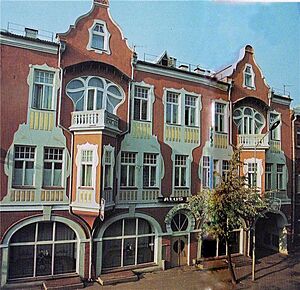
Daugavpils is a key cultural center in eastern Latvia. It has 22 primary and secondary schools. There are also four vocational schools and the Saules College of Art. Each year, over 1,000 teachers and engineers graduate from the University of Daugavpils and the local branch of Riga Technical University.
There is also a Polish gymnasium (a type of academic secondary school) on Varšavas iela (Warsaw Street).
Historical City Center
The historical center of Daugavpils is a very important national treasure. Its buildings were mostly constructed in the 19th century. The design was approved in St. Petersburg in 1826.
The historical center is a major attraction. It shows a great mix of old and new styles. Daugavpils is one of the few cities in Latvia with so many buildings in classic and eclectic styles. The old buildings, art, and history, along with the beautiful surroundings, make Daugavpils special.
In 2020, the city spent 70,000 euros to fix up eight historical buildings. These included Art Nouveau and red brick buildings.
Here are some of the most important historical and cultural places in Daugavpils:
- Daugavpils fortress - built from 1810 to 1878. The Mark Rothko Art centre opened here in 2013.
- St. Peter-in-Chains Catholic Church - the oldest church still standing in the city. It was built in 1845-1848.
- Alexander Nevsky Cathedral - an Orthodox church built from 1999 to 2003. It stands where an older cathedral once was.
- Daugavpils Synagogue - built in 1850.
- Church Hill (Baznīci kalnas) - a place where four different Christian churches are located close to each other.
- Daugavpils Theatre - built in 1937-1938 and restored in 2007.
- Socialist realist buildings of the Daugavpils railway station and the University of Daugavpils.
- Daugavpils Regional Studies and Art Museum.
Red Brick Buildings
Daugavpils has many beautiful red brick buildings. Many famous architects designed them. Wilhelm Neumann, a German architect, was the city's chief architect from 1878 to 1895. He designed many of these buildings. You can see great examples at 1/3 Saules Street and 8 Muzeja Street. These buildings show amazing detail and design.
Getting Around Daugavpils
Daugavpils satiksme AS manages the city's bus and tram systems.
The city's railway station is the end point of the Riga–Daugavpils Railway.
A former Soviet Air Force base is located at Lociki, about 12 km (7 mi) northeast of the city center. It could be used as a civilian airport in the future. Griva Airfield is also nearby, used for activities like parachute jumping.
City Economy
Some important companies in Daugavpils include:
- Daugavpils Locomotive Repair Plant (Daugavpils Lokomotīvju Remonta Rūpnīca)
- Ditton Driving Chain Factory (Ditton pievadķēžu rūpnīca)
- Latvijas Maiznieks bread factory
- Ziegler GmbH machine works
During the Soviet era, Daugavpils had many large factories. Today, only some of them are still working. The city council is trying to bring in new businesses. They have created special industrial zones around the city. These zones are good for businesses because Daugavpils is close to the borders of Russia, Belarus, and Lithuania.
Sports in Daugavpils
The Speedway Grand Prix of Latvia is held at the Latvijas Spīdveja Centrs. Speedway is a type of motorcycle racing. Greg Hancock, a three-time World Champion, has won the GP in Latvia many times. Lokomotiv Daugavpils is a local speedway team that races in the Polish league.
The football club BFC Daugavpils plays at Celtnieks Stadium. They play in the top Latvian league. In the past, there was another team called Dinaburg FC.
FBC Latgale is the city's floorball team. There is also an hockey team called HK Dinaburga. They play in the Latvian Hockey Higher League.
The Daugavpils Multifunctional Sports Complex was built between 2008 and 2009.
Famous People from Daugavpils
Many notable people have come from Daugavpils, including:
- Andris Ambainis (born 1975), a computer scientist
- Konstantīns Calko (born 1994), a racing driver
- Aleksandrs Cauņa (born 1988), a footballer
- Movsas Feigins (1908–1950), a chess master
- Grzegorz Fitelberg (1879–1953), a composer and conductor
- Isser Harel (c. 1912–2003), an Israeli spymaster
- Gotthard Kettler (1517–1587), a historical duke
- Abraham Isaac Kook (1864–1935), a rabbi and scholar
- Solomon Mikhoels (1890–1948), an actor and director
- Viktoria Modesta (born 1988), a singer-songwriter
- Nicolai Poliakoff (1900–1974), creator of Coco the Clown
- Mark Rothko (1903–1970), a famous painter
- Artjoms Rudņevs (born 1988), a footballer
- Uljana Semjonova (born 1952), a basketball player
- Deniss Vasiļjevs (born 1999), a figure skater
- Vitas (born 1979), a singer
Sister Cities
Daugavpils is connected with many cities around the world. These are called sister cities:
 Alaverdi, Armenia
Alaverdi, Armenia Babruysk, Belarus
Babruysk, Belarus Batumi, Georgia
Batumi, Georgia Central Administrative Okrug (Moscow), Russia
Central Administrative Okrug (Moscow), Russia Ferrara, Italy
Ferrara, Italy Harbin, China
Harbin, China Kharkiv, Ukraine
Kharkiv, Ukraine Lida, Belarus
Lida, Belarus Magdeburg, Germany
Magdeburg, Germany Motala, Sweden
Motala, Sweden Naro-Fominsk, Russia
Naro-Fominsk, Russia Panevėžys, Lithuania
Panevėžys, Lithuania Pskov, Russia
Pskov, Russia Radom, Poland
Radom, Poland Ramla, Israel
Ramla, Israel Saint Petersburg, Russia
Saint Petersburg, Russia Vagharshapat, Armenia
Vagharshapat, Armenia Vitebsk, Belarus
Vitebsk, Belarus
Images for kids
See also
 In Spanish: Daugavpils para niños
In Spanish: Daugavpils para niños



